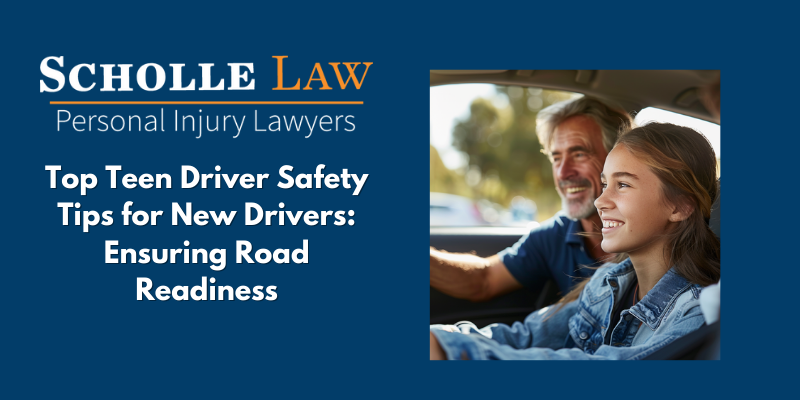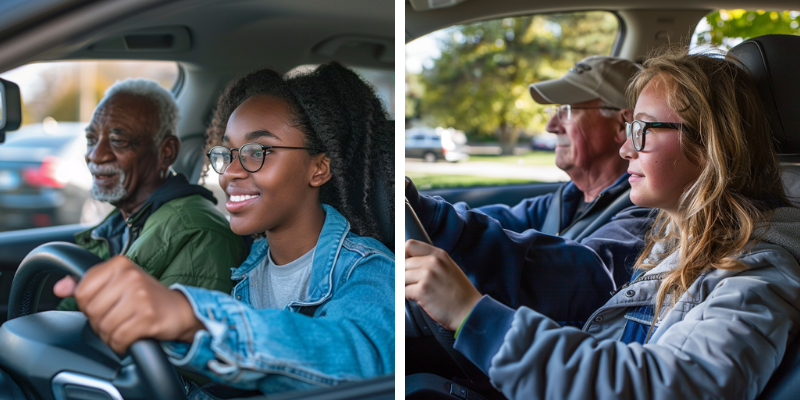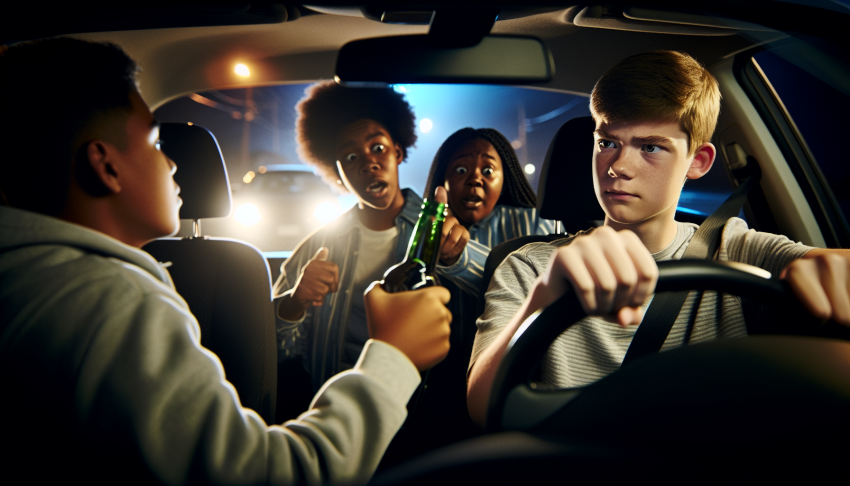4.9 Rating
Google REVIEWS
Leaders in Georgia Personal Injury Law Since 1995
Top Teen Driver Safety Tips for New Drivers: Ensuring Road Readiness
Are you a parent seeking to equip your teen with the best practices for road safety? Understanding teen driver safety tips is key to preventing accidents and fatalities. This guide from Scholle Law Car & Truck Accident Attorneys, provides clear, actionable strategies for young drivers to develop responsible habits and for parents to effectively support their journey toward becoming safe, skilled drivers.

Key Takeaways
- ● Teen drivers face the highest risk of fatal crashes due to factors such as speeding, distractions, and inexperience, underscoring the importance of cultivating safe driving practices and instilling a sense of responsibility behind the wheel.
- ● The Graduated Driver Licensing (GDL) system plays a critical role in teen driver safety by providing a structured path from learner’s permit to full licensure, which gradually introduces young drivers to various driving situations, helping to build experience and confidence while reducing risk of accidents.
- ● Parental involvement is crucial in promoting teen driver safety, serving as role models, setting rules and consequences, providing support and guidance, and leading discussions about the risks of impaired and drowsy driving, which are severe threats to teens on the road.

Establishing Safe Driving Habits
The sobering reality is that motor vehicle crashes are the leading cause of death for teens, making the cultivation of teen drivers safe driving practices not just beneficial but essential for survival. Every time a young driver gets behind the wheel, they must be fully equipped to combat the risky behaviors that are all too common among their peers, such as speeding, tailgating, and making critical decision errors—risks that escalate when other teens are passengers. Through proper education and a commitment to safe driving behaviors, these novice drivers can transform from potential statistics into exemplars of road safety.
One of the most impactful ways to instill safe driving habits is through supervised practice. Studies have shown a marked decrease in the incidence of crashes when an adult is present in the vehicle, underscoring the significance of hands-on guidance during the learning process. By pairing driving theory with practical experience under adult supervision, teen drivers can develop the confidence and skill necessary to navigate the complexities of the road with a sense of responsibility and caution.
The journey to becoming a safe driver is not a solo endeavor but a collaborative effort between the teen, their parents, and the larger community, including organizations like the Governors Highway Safety Association and the Highway Safety Association. It’s a path lined with clear rules, consistent practice, and a steadfast commitment to the well-being of everyone on the road. As young drivers embrace these principles, they not only protect themselves but also contribute to the overall safety of our streets and highways.
Avoiding Distractions
Amid the buzz of daily life, the allure of distractions is ever-present, especially for teen drivers. The simple act of dialing a phone number while driving can sextuple the risk of a crash, while texting increases it by an alarming 23 times. Beyond the ubiquitous cell phone, additional distractions such as eating, applying makeup, or changing the radio station can significantly detract from a driver’s ability to focus on the road and react to unforeseen circumstances.
With teen passengers and electronic devices being top contributors to passenger vehicle teen drivers’ accidents, it’s clear that keeping distractions at bay is not just a recommendation—it’s a non-negotiable element of teen driving safety.
Following Speed Limits
Speeding is not a trivial matter; it’s a life-threatening risk that teen drivers must consciously avoid. A staggering 32% of fatal crashes involving 15 to 18-year-olds in 2021 were linked to speeding, a slight increase from 27% in 2019, illustrating its persistent danger. As teen drivers gain more confidence on the road, there’s a tendency for speeding behaviors to escalate, making continuous reinforcement of speed limit adherence a crucial aspect of their driving education.
Given the inexperience of teenage drivers, the potential for speeding to lead to irreversible consequences is a stark reminder of the importance of vigilance and restraint behind the wheel.
Wearing Seat Belts
In the event of an accident, a seat belt can be the thin line between life and death. Research indicates that seat belts reduce the risk of fatal injury to front-seat occupants by 45% and any injury by half, making their use a fundamental aspect of driving safety. Despite this knowledge, seat belt use among teenagers remains disturbingly low, with many fatal crash victims found unbuckled.
The use of seat belts by teens and young adults has hovered around 87% from 2016 to 2019, signaling an urgent need to elevate this practice to an unbreakable habit. As these young drivers harness the protective power of their seat belts, they fortify their defenses against the unpredictable nature of the road.
Graduated Driver Licensing (GDL) System
The Graduated Driver Licensing (GDL) system serves as a structured blueprint to guide inexperienced drivers safely from their initial foray into driving to the point where they are fully licensed and ready to take on the road independently. This system reflects a strategic approach to bolstering teen driving safety, offering a phased journey that introduces young drivers to the nuances of driving within a controlled and supportive framework.
Through the GDL system, teens are gradually exposed to various driving scenarios, helping them to build experience and confidence, while minimizing their risk of accidents.

Learner’s Permit Stage
The first stage of the GDL system is the learner’s permit, where the foundational skills of driving are honed under the watchful eye of a fully licensed adult. States mandate a certain number of practice hours, with some requiring as many as 50, including 10 hours of nighttime driving, to ensure that learners are exposed to a broad range of driving experiences before progressing. This stage is not only about clocking hours but about absorbing the subtleties of safe driving practices that will serve these young motorists throughout their lives.
The verification of these hours, often certified by a parent or guardian, is a legal requirement and a testament to the collective responsibility to foster competent, cautious drivers.
Provisional License Stage
Upon satisfying the learner’s permit requirements, teen drivers graduate to the provisional license stage, which introduces a new level of independence alongside critical restrictions. This stage is characterized by limitations on unsupervised driving, such as curfews to avoid late-night driving and passenger restrictions to minimize in-car distractions. These provisions are designed to let young drivers gradually acclimate to driving without adult supervision while still operating within a safety net that curtails high-risk behaviors.
The provisional license represents a significant milestone in the GDL journey, one step closer to full licensure and the comprehensive freedoms and responsibilities it brings.
Full Licensure Stage
The culmination of the GDL process is the attainment of full licensure, a momentous event that signifies a teen’s readiness to embrace the full spectrum of driving privileges. After successfully navigating the learning and provisional stages, young drivers emerge with a wealth of knowledge and experience that equips them to handle the complexities of the road with maturity and skill.
This final phase of the GDL system is not the end of the road for learning but rather the beginning of a lifelong journey of safe and responsible driving.

The Role of Parents in Teen Driver Safety
The influence of parents on teen driver safety is profound and multi-dimensional. They are the architects of their teen’s driving attitudes, the enforcers of rules, and often the first responders in the event of driving queries or concerns.
The American Academy of Pediatrics suggests that teens should not receive an unrestricted license until they are eighteen or have at least two years of driving experience under adult supervision, highlighting the weight of parental involvement in the early driving years. Through a combination of leadership, guidance, and support, parents can steer their teens towards a path of safe driving that lasts well beyond the teen years.
Leading by Example
Parents are the mirror in which their teen drivers see the reflection of what it means to drive safely. By consistently wearing seat belts, obeying speed limits, and practicing responsible alcohol use, parents set the bar for safe driving behaviors. The message sent through these actions is clear: safety is paramount, and it begins with each individual’s choices behind the wheel.
When parents choose not to speed, discuss the importance of seat belt use, and demonstrate moderation in alcohol consumption, they instill in their teens the values that will protect them on every journey.
Setting Rules and Consequences
The establishment of clear and consistent rules is a fundamental pillar in the fostering of safe driving habits. Parents who set specific guidelines regarding distracted driving, curfew times, and passenger limits—and who lead by example—are able to convey the seriousness of driving responsibilities. When teens participate in forming these household driving rules, they are more likely to adhere to them, understanding their rationale and significance.
Moreover, the consequences of breaking these rules, such as probationary measures for DUI offenses, serve as a stern reminder of the gravity of their driving choices.
Offering Support and Guidance
The support and guidance parents offer can make all the difference in a teen’s driving development. Supervised practice sessions are not merely about logging hours but are opportunities for teaching, learning, and reinforcing safe driving practices. The handing over of car keys can be a moment of teaching, where parents discuss driving plans and reiterate safety expectations.
Open lines of communication and mutual trust are foundational to addressing driving-related responsibilities and concerns, potentially even leveraging resources like structured practice guides to aid in tracking progress and setting goals.
Understanding the Dangers of Impaired Driving
Impaired driving due to drug and alcohol use is a critical threat to teen driving safety, with alcohol or other drugs rendering driving not just dangerous, but also illegal for underage individuals. The consequences of driving under the influence are severe, with the potential for deadly outcomes that could have been avoided.
This section underscores the gravity of impaired driving and the heavy toll it can take on a teen’s future, both legally and academically.

Legal and Academic Penalties
The legal ramifications of a DUI conviction for a teenager can be staggering, ranging from hefty fines and license suspension to jail time—even for first-time offenders. Zero tolerance laws underscore the severity of underage drinking and driving, with a BAC limit set at 0.02% or lower.
The academic repercussions are equally daunting, with the possibility of school suspension or expulsion, roadblocks in college admissions, and compromised scholarship opportunities, all of which can cast a long shadow over a teen’s future prospects.
Prevention Strategies
Parents hold the key to preventing impaired driving among teens. By engaging in frank discussions about the dangers of alcohol and drugs, setting firm rules against their use before driving, and providing a safe means of return when needed, parents can significantly lower the risk of their teens making life-altering mistakes. Education on resisting peer pressure and understanding state DUI laws are further measures that reinforce the importance of making smart, safe choices.
Being the ‘scapegoat’ for a teen’s safe exit from a risky situation can be lifesaving, underscoring the pivotal role parents play in safeguarding their children.

The Impact of Drowsy Driving on Teen Safety
Drowsy driving is an often-underestimated threat to teen drivers, contributing to thousands of preventable deaths each year. Teens and young adults are particularly vulnerable, with statistics showing that they are involved in at least half of the over 6,000 annual fatal crashes attributed to drowsy driving.
This section explores the critical link between sufficient sleep and driving performance, offering actionable advice to combat the dangers of drowsy driving.
Sleep and Driving Performance
The importance of adequate sleep for maintaining alertness and reaction times on the road cannot be overstated, especially for teen drivers who require between 8 to 10 hours of sleep each night. The consequences of sleep deprivation are dire, as it impairs driving abilities, slows reaction times, and increases the likelihood of involvement in car crashes.
Disrupted sleep patterns, common among teenagers, can further exacerbate the risk, making consistent sleep habits a cornerstone of teen driving safety.
Tips for Combating Drowsy Driving
To safeguard against the perils of drowsy driving, teens must prioritize their sleep schedule, aiming for the recommended hours each night and maintaining consistency, even on weekends. Establishing a soothing bedtime routine, such as avoiding screen time before bed and waking up with natural light, can significantly enhance sleep quality and, by extension, driving alertness.
Steering clear of caffeine in the evening and opting for a light snack if needed before bed can further promote restful sleep, equipping teens for the demands of driving.
Navigating Road Hazards and Challenging Conditions
The unpredictable nature of driving necessitates a certain level of preparedness to handle road hazards and challenging conditions effectively. Whether it’s adverse weather or an unexpected mechanical issue, knowing how to respond can mean the difference between safely navigating a situation or becoming another accident statistic.
This section provides new drivers, especially teen drivers, with the knowledge and strategies needed to remain calm, make informed decisions, and take appropriate actions in various driving scenarios.
Weather-Related Challenges
Weather can change driving conditions in an instant, and it’s crucial for teen drivers to know how to adapt. When rain begins to fall, slowing down, increasing the distance from the car ahead, and using headlights are key steps to maintaining visibility and reducing the risk of hydroplaning.
In snowy or icy conditions, the importance of reducing speed and allowing for longer stopping distances cannot be overstated, as these actions can prevent the loss of vehicle control. Ensuring that windshield wipers and defrosters are in working order is also essential to keep visibility clear in any type of inclement weather.
Dealing with Emergencies
Emergency situations test a driver’s ability to remain composed and act decisively. Here are some tips for handling common emergencies:
- Tire blowout: Grip the steering wheel firmly, avoid slamming on the brakes, and gradually slow down to pull over safely.
- Brake failure (cars without ABS): Pump the brake pedal to try to regain some braking power.
- Brake failure (cars with ABS): Shift to a lower gear to help slow down and bring the vehicle to a stop.
Remember, staying calm and following these steps can help you navigate emergency situations safely.
It’s also wise to have an emergency kit in the car, especially for sport utility vehicles, equipped with essentials like a spare tire, flares, and a first-aid kit, to be prepared for the unexpected.
Summary
As we reach the end of our journey through the essentials of teen driver safety, it’s clear that the road to becoming a confident and responsible driver is paved with education, practice, and support. From establishing foundational safe driving habits to understanding the dangers of impaired and drowsy driving, each step is vital in safeguarding the lives of young motorists. Parents play an indispensable role as teachers and role models, and the structured progression through the GDL system ensures that teens build their driving skills on solid ground. With these strategies in place, the once-daunting prospect of teen driving becomes a manageable and, ultimately, rewarding experience that sets the stage for a lifetime of safe travel.
Frequently Asked Questions
What's the biggest factor leading to teen crashes?
The biggest factor leading to teen crashes is the combination of lack of scanning, speeding, and distractions while driving. These critical errors contribute to most teen driver crashes.
What are some driving safety tips?
To drive safely, remember to be courteous to other drivers, always buckle up, pay attention and avoid distractions, adjust your driving to weather conditions, and obey traffic signals. Additionally, get enough rest before long drives, avoid nighttime driving, maintain a cool temperature in your vehicle, and stay actively engaged in driving without relying on cruise control.
What is the first thing a driver should do to drive safely at night?
The first thing a driver should do to drive safely at night is to ensure that their headlights are clean, bright, and properly adjusted. This will help improve visibility and reduce the risk of accidents.
What are the most common distractions for teen drivers?
The most common distractions for teen drivers are using a cell phone, interacting with passengers, eating, applying makeup, and changing the radio station. These distractions should be avoided to ensure safe driving.
How do speed limits affect teen driver safety?
Adhering to speed limits is crucial for teen drivers as speeding significantly increases the risk of fatal crashes, especially for inexperienced young drivers. It is important for teens to understand and follow speed limits to ensure safety on the road.
